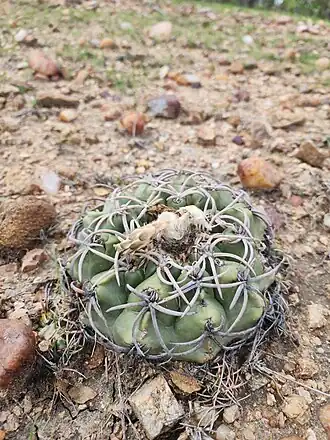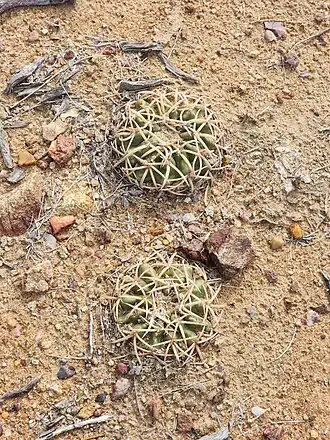Discocactus bahiensis
| Discocactus bahiensis | |
|---|---|

| |
| Scientific classification | |
| Kingdom: | Plantae |
| Clade: | Tracheophytes |
| Clade: | Angiosperms |
| Clade: | Eudicots |
| Order: | Caryophyllales |
| Family: | Cactaceae |
| Subfamily: | Cactoideae |
| Genus: | Discocactus |
| Species: | D. bahiensis
|
| Binomial name | |
| Discocactus bahiensis Britton & Rose 1922
| |
| Synonyms | |
| |
Discocactus bahiensis is a species of Discocactus from Brazil.[3]
Description
Discocactus bahiensis grows solitary and rarely clumping, with heavily spined. The stems are pale green, depressed spherical to spherical bodies that reach diameters of 5.5 to 18 cm and 3 to 7 cm tall. They usually grow with the stem buried in the soil, either partially or completely, and their roots are somewhat thickened, and napiform. There are 10 to 15 ribs with well-developed tubercles and 2 to 5 oval areole per rib. The areoles are 3 to 10 mm long and 3 to 8 mm wide, woolly becoming glabrous with age, with 5 to 14 backward-curved spines. The spines are stiff, woody and creamy to gray-brown and measure 0.6 to 4.5 cm long and 0.5 to 3 mm wide. The prominent cephalium is formed of white wool and a few short bristles measuring 2.2 to 4.7 cm tall and 0.9 to 2.1 cm wide. The slender, funnel-shaped, sweet-scented,yellowish white flowers arise from the edge of the cephalium. The flowers open at night and are 4–7 cm long and 2.3–5.4 cm in diameter, and the buds are green to brown. Flowering occurs between November and February, peaking in January, when most plants bear 1–5 flowers at a time. The fruits are globular and slightly fleshy, small and red measuring 1.2–5 cm long and 0.7–1 cm wide. The seeds are oval and black[4][5]
Subspecies
Accepted Subspecies:[6]
| Image | Subspecies | Description | Distribution |
|---|---|---|---|
_P.J.Braun_%2526_Esteves.jpg) |
Discocactus bahiensis subsp. bahiensis | Plants reach diameters of up to 7 cm. It usually has between 10 and 16 well-defined ribs. | Brazil (Ceará, N. Bahia) |
 |
Discocactus bahiensis subsp. gracilis P.J.Braun & Esteves | Plants have smaller, thinner stem, reaching approximately 6 cm in diameter. It has about 10 ribs, which are often almost hidden by the dense covering of spines. | Brazil (Bahia) |
Distribution
Discocactus bahiensis is a cactus species native to the Brazilian states of Bahia, Ceará, Pernambuco, and Piauí at altitudes between 380 and 650 meters. Plants are found growing in rocky and sandy loam, , among iron-stained limestone or quartzite formations, near rivers and flood plains.[7]
-
 Discocactus bahiensis bahiensis in habitat in Bahia, Brazil
Discocactus bahiensis bahiensis in habitat in Bahia, Brazil -
 Plant growing in habitat in Bahia, Brazil
Plant growing in habitat in Bahia, Brazil
Taxonomy
It was first described in 1922 by Nathaniel Lord Britton and Joseph Nelson Rose. The species name "bahiensis" specifically denotes its presence in Bahia, Brazil.
References
- ^ Kew), Nigel Taylor (RBG; Assessment), Pierre Braun (Global Cactus (2010-06-04). "The IUCN Red List of Threatened Species". IUCN Red List of Threatened Species. Retrieved 2024-01-22.
- ^ "Appendices | CITES". cites.org. Retrieved 2022-01-14.
- ^ "Discocactus bahiensis in Tropicos".
- ^ Anderson, Edward F.; Eggli, Urs (2005). Das grosse Kakteen-Lexikon (in German). Stuttgart (Hohenheim): Ulmer. ISBN 3-8001-4573-1.
- ^ Santos, Marianna Rodrigues (2013-11-13). "Filogenia molecular, taxonomia, biogeografia e conservação de Discocactus Pfeiff. (Cactaceae)" (in Portuguese). Universidade Federal de Viçosa. Retrieved 2025-08-04.
- ^ "Discocactus bahiensis Britton & Rose". Plants of the World Online. 1989-01-01. Retrieved 2025-08-04.
- ^ "Discocactus bahiensis". LLIFLE. 2013-08-04. Retrieved 2024-01-22.
External links
 Media related to Discocactus bahiensis at Wikimedia Commons
Media related to Discocactus bahiensis at Wikimedia Commons Data related to Discocactus bahiensis at Wikispecies
Data related to Discocactus bahiensis at Wikispecies
